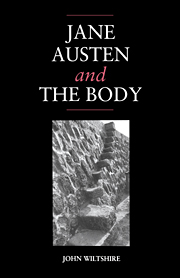Book contents
- Frontmatter
- Contents
- Acknowledgements
- A note on texts
- Introduction: Jane Austen and the body
- 1 Sense, sensibility and the proofs of affection
- 2 ‘Eloquent blood’: the coming out of Fanny Price
- 3 Emma: the picture of health
- 4 Persuasion: the pathology of everyday life
- 5 Sanditon: the enjoyments of invalidism
- Notes
- Bibliography
- Index
3 - Emma: the picture of health
Published online by Cambridge University Press: 11 November 2009
- Frontmatter
- Contents
- Acknowledgements
- A note on texts
- Introduction: Jane Austen and the body
- 1 Sense, sensibility and the proofs of affection
- 2 ‘Eloquent blood’: the coming out of Fanny Price
- 3 Emma: the picture of health
- 4 Persuasion: the pathology of everyday life
- 5 Sanditon: the enjoyments of invalidism
- Notes
- Bibliography
- Index
Summary
Educators, naturally enough, have read Emma as a novel about education. More sophisticated, or more self-conscious, latterday authors and readers have thought it to be about authorship, or about reading. Many accounts exist which see it as a novel about perception, or understand it in epistemological terms, or interpret it as a novel of hermeneutics. Some have even fancied Emma to be about its heroine's imagination. There is hardly a critic who, once having entered the close and intricate world the novel constructs, has not found it hospitable to a coherent and plausible reading, or who has not found something new and interesting to observe in Highbury. But with very few exceptions, no one has yet diagnosed Emma to be a novel concerned with health.
One exception is J. R. Watson's article ‘Mr Perry's patients: a view of Emma’ (1970) and, taking his hint, I will begin this exploration of matters of health in the novel by noting the predominance of this figure, the country apothecary or local doctor, who historically is the precursor of the general practitioner. Except that predominance is hardly the word, for Mr Perry, though very well known to all the novel's readers, never actually appears on its pages. He is omnipresent and very active, but scarcely seen, cloistered with Mr Woodhouse whilst the drama goes on elsewhere, or glimpsed occasionally as he rides about the village, or when Emma catches sight of him ‘walking hastily by’ as she is waiting for Harriet outside Ford's, referred to (every twenty or thirty pages): implied, but not presented.
- Type
- Chapter
- Information
- Jane Austen and the Body'The Picture of Health', pp. 110 - 154Publisher: Cambridge University PressPrint publication year: 1992



